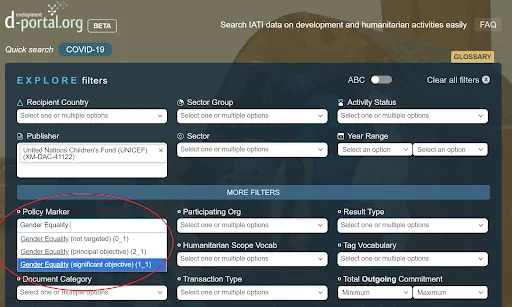Improving the quality of gender data within IATI reporting
This post has been written by Navin Haram, Strategic Planning Specialist at UN Women, and Jieru Zheng, Programme Manager and Joseph Barnes, Chief of Monitoring at UNICEF. UNICEF is an IATI Governing Board member.
Last month Publish What You Fund (PWYF) released its report: Making gender financing more transparent, which focuses on how to improve the publication of financial and programmatic gender equality data. Tracking financial allocations and monitoring how and where they are spent is key to increasing accountability in financing for gender equality. The 2030 Sustainable Development Goals (SDGs) pledge to “leave no one behind” recognises that despite progress made in many countries around the world, gender inequality is still a global problem.
It was positive to see the research conclude that commendable efforts have been made by international donors and data platforms, including IATI, to provide and make available data on gender financing.
However, the report also highlights that improvements are needed, as meeting the ambitious global targets on gender equality, including SDG 5, requires transparent information from across all providers of development resources. The report calls for good quality open data to drive effective planning, coordination and evaluation of activities. With the COVID-19 pandemic disproportionately impacting women and girls, it is more important than ever for the international community to deliver better data to ensure that efforts on gender equality are evidence-based and decision makers are held accountable.
Publishing gender equality data to IATI
UN Women and UNICEF both publish data to IATI on our development and humanitarian funding and activities, and we strive to ensure that it is useful to those working to advance gender equality. For example, for every activity on which our organisations have published data (which together numbers more than 15,000), we have provided information on whether it is addressing gender equality or not.
We are able to provide this data thanks to the IATI Standard, together with the OECD-DAC’s Gender Equality Policy Marker. This enables data users, for example, those working for NGOs, INGOs, UN agencies, and women's rights organisations (WROs) to find out using IATI’s search platform: d-portal.org and other data use tools, which of our activities, along with the activities of many other organisations, are delivering gender equality projects.

The report praised IATI for enabling publishers to use the OECD-DAC’s Gender Equality Policy Marker. As part of an assessment of a number of open data initiatives and platforms, it also highlighted additional ways in which the IATI Standard enables the publication of good quality gender financing data:
- Of the global databases that were assessed, the research found that only IATI allows organisations to systematically publish detailed results type information, including evaluations.
- Among the data sources assessed, they identified that only IATI offers data publishers and users guidance on what constitutes sensitive data and how to create exclusion policies.
- PWYF also praised IATI for enabling the publication of timely data, encouraging publishers to refresh their data monthly or even daily.
Much work to do
Though positive about efforts made so far, the research shows there’s much work to do to ensure gender equality stakeholders are able to access good quality data. They found that 64% of stakeholders interviewed were in some way dissatisfied with publicly available financial and programmatic gender data.
The report recognises that IATI has an important role to play in improving the data and we want to raise awareness of their recommendations:
- Donors to publish information on the OECD-DAC Gender Equality Policy Marker using the IATI Standard, and IATI to offer clear resources on how reporting agencies can apply the OECD-DAC Gender Equality Policy Marker to their IATI data (e.g., through manuals or instructional videos).
- Donors to provide underlying documentation to explain their assigned gender marker scores. Publishers should be encouraged to include gender analyses in existing document types (e.g., pre-project impact appraisal documents, evaluation, or review documents).
- Donors to publish timely and activity-specific IATI data on target gender group(s) (including characteristics such as age groups and disability status), gender disaggregated objectives and results (including evaluations/review documents, mentioning their publication frequency), and sub-national locations.
- For greater comparability of data, IATI should encourage publishers to clearly indicate whether they publish related data to other platforms and to include links.
- To better understand the impact of activities published using OECD-DAC Gender Equality Policy Markers, IATI should encourage publishers to publish results fields.
We welcome the clear and specific recommendations for improving the availability of gender equality data published to IATI; and will share this report with the UN Transparency Task Force for consideration and action. We will also work with the IATI Governing Board and IATI Secretariat to identify how the Initiative can best support organisations to both publish and use good quality gender data.
Accelerating progress towards fully realising gender equality as a human right is also essential to delivering on the Sustainable Development Goals. As UN Women and UNICEF, we will continue to deliver on our commitment to transparency in all our contributions to meeting the human rights of women and girls.